
Champion of the Seas was the second largest clipper ship destined for the Liverpool, England - Melbourne, Australia passenger service. Champion was ordered by James Baines of the Black Ball Line from Donald McKay. She was launched 19 April 1854 and was abandoned 3 January 1877, off Cape Horn.
The first USS Onward was a clipper in the Union Navy.

White Swallow was an extreme clipper built in Boston in 1853 for the California trade.
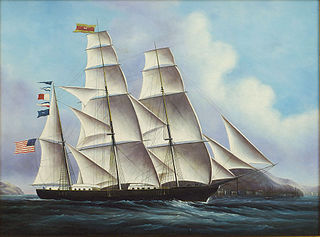
Houqua was an early clipper ship with an innovative hull design, built for A.A. Low & Brother in 1844. She sailed in the China trade.
Carrier Pigeon was an American clipper ship that was launched in the fall of 1852 from Bath, Maine. Her value was estimated at US$54,000. She was wrecked on her maiden voyage off the north coast of what was then Santa Cruz County in the state of California.

Carrier Dove was an 1855 medium clipper. She was one of two well-known clippers launched in Baltimore that year, the other being Mary Whitridge.
Harriet Hoxie was an 1851 clipper in the California trade. She was known for carrying cargoes of whale oil from Honolulu, and for importing the first Brown Leghorn chickens to the United States.
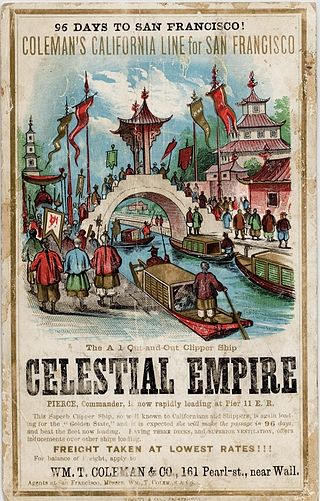
Celestial Empire was a long-lived medium clipper ship built in 1852 for the San Francisco trade. She met with a variety of mishaps characteristic for ships of her era. A second ship by this name set a legal precedent regarding damage done by sailing ships coming in to dock.

Herald of the Morning was one of the few clipper ships with a passage to San Francisco in less than 100 days.

The Memnon was the first clipper ship to arrive in San Francisco after the Gold Rush, and the only clipper to arrive in San Francisco before 1850. Built in 1848, she made record passages to San Francisco and to China, and sailed in the first clipper race around Cape Horn.
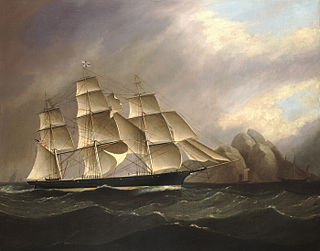
Ocean Telegraph was a clipper ship that was built in Massachusetts in 1854 and was last known of in Gibraltar in 1923. She was in US ownership until 1863, when UK interests bought her and renamed her Light Brigade.

John Gilpin was an 1852 clipper in the California trade, named after the literary character John Gilpin. The ship was known for its 1852 race against the clipper Flying Fish, and for its collision with an iceberg.
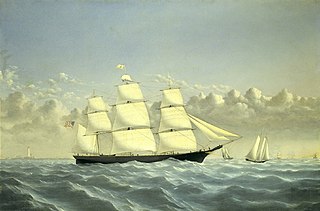
Golden West was an 1852 extreme clipper built by Paul Curtis. The ship had a very active career in the California trade, the guano trade, the coolie trade, the Far East, and Australia. She made a record passage between Japan and San Francisco in 1856.

Golden Fleece was an 1855 medium clipper in the California trade, built by Paul Curtis. She was known for arriving with cargoes in good condition, for making passages in consistently good time, and for catching fire with a load of ice.

Witch of the Wave was a long-lived extreme clipper in the California trade, with a sailing life of over 34 years. In 1851, she sailed from Calcutta to Boston in 81 days, setting a record.

The sailing ship Andrew Jackson, a 1,679-registered-ton medium clipper, was built by the firm of Irons & Grinnell in Mystic, Connecticut in 1855. The vessel was designed for the shipping firm of J.H. Brower & Co. to carry cargo intended for sale to participants in the California Gold Rush.

Comet was an 1851 California clipper built by William H. Webb which sailed in the Australia trade and the tea trade. This extreme clipper was very fast. She had record passages on two different routes: New York City to San Francisco, and Liverpool to Hong Kong, and beat the famous clipper Flying Dutchman in an 1853 race around the Horn to San Francisco.
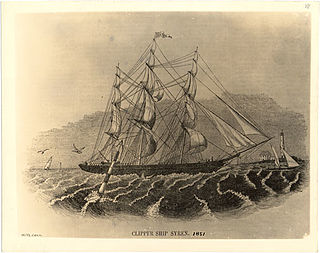
Syren was the longest lived of all the clipper ships, with a sailing life of 68 years 7 months. She sailed in the San Francisco trade, in the Far East, and transported whaling products from Hawaii and the Arctic to New Bedford.

Hurricane was a large extreme clipper of 1608 tons burthen built in Hoboken, New Jersey, United States in 1851. Reputedly the most extreme clipper ever built, Hurricane proved a very fast vessel, reportedly capable of speeds of up to 18 knots (33 km/h) in ideal conditions, and establishing a number of record passages in the early years of her career.
Santa Claus was an American medium clipper ship built in Boston by Donald McKay in 1854. In the course of her career, she made three voyages from the East Coast of the United States to San Francisco, California, the fastest of which was a comparatively swift 128-day passage in the winter of 1857–1858. The ship was mainly engaged in the guano trade and in trade to the Far East. In 1858, she brought Chinese immigrants to California; according to one source, she was also at one time engaged in the coolie trade.
















